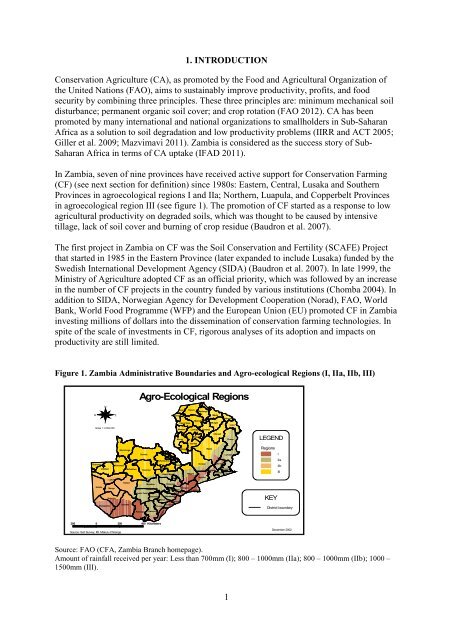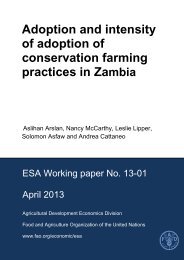Adoption and intensity of adoption of conservation farming practices in Zambia
Adoption and intensity of adoption of conservation farming practices in Zambia
Adoption and intensity of adoption of conservation farming practices in Zambia
You also want an ePaper? Increase the reach of your titles
YUMPU automatically turns print PDFs into web optimized ePapers that Google loves.
1. INTRODUCTION<br />
Conservation Agriculture (CA), as promoted by the Food <strong>and</strong> Agricultural Organization <strong>of</strong><br />
the United Nations (FAO), aims to susta<strong>in</strong>ably improve productivity, pr<strong>of</strong>its, <strong>and</strong> food<br />
security by comb<strong>in</strong><strong>in</strong>g three pr<strong>in</strong>ciples. These three pr<strong>in</strong>ciples are: m<strong>in</strong>imum mechanical soil<br />
disturbance; permanent organic soil cover; <strong>and</strong> crop rotation (FAO 2012). CA has been<br />
promoted by many <strong>in</strong>ternational <strong>and</strong> national organizations to smallholders <strong>in</strong> Sub-Saharan<br />
Africa as a solution to soil degradation <strong>and</strong> low productivity problems (IIRR <strong>and</strong> ACT 2005;<br />
Giller et al. 2009; Mazvimavi 2011). <strong>Zambia</strong> is considered as the success story <strong>of</strong> Sub-<br />
Saharan Africa <strong>in</strong> terms <strong>of</strong> CA uptake (IFAD 2011).<br />
In <strong>Zambia</strong>, seven <strong>of</strong> n<strong>in</strong>e prov<strong>in</strong>ces have received active support for Conservation Farm<strong>in</strong>g<br />
(CF) (see next section for def<strong>in</strong>ition) s<strong>in</strong>ce 1980s: Eastern, Central, Lusaka <strong>and</strong> Southern<br />
Prov<strong>in</strong>ces <strong>in</strong> agroecological regions I <strong>and</strong> IIa; Northern, Luapula, <strong>and</strong> Copperbelt Prov<strong>in</strong>ces<br />
<strong>in</strong> agroecological region III (see figure 1). The promotion <strong>of</strong> CF started as a response to low<br />
agricultural productivity on degraded soils, which was thought to be caused by <strong>in</strong>tensive<br />
tillage, lack <strong>of</strong> soil cover <strong>and</strong> burn<strong>in</strong>g <strong>of</strong> crop residue (Baudron et al. 2007).<br />
The first project <strong>in</strong> <strong>Zambia</strong> on CF was the Soil Conservation <strong>and</strong> Fertility (SCAFE) Project<br />
that started <strong>in</strong> 1985 <strong>in</strong> the Eastern Prov<strong>in</strong>ce (later exp<strong>and</strong>ed to <strong>in</strong>clude Lusaka) funded by the<br />
Swedish International Development Agency (SIDA) (Baudron et al. 2007). In late 1999, the<br />
M<strong>in</strong>istry <strong>of</strong> Agriculture adopted CF as an <strong>of</strong>ficial priority, which was followed by an <strong>in</strong>crease<br />
<strong>in</strong> the number <strong>of</strong> CF projects <strong>in</strong> the country funded by various <strong>in</strong>stitutions (Chomba 2004). In<br />
addition to SIDA, Norwegian Agency for Development Cooperation (Norad), FAO, World<br />
Bank, World Food Programme (WFP) <strong>and</strong> the European Union (EU) promoted CF <strong>in</strong> <strong>Zambia</strong><br />
<strong>in</strong>vest<strong>in</strong>g millions <strong>of</strong> dollars <strong>in</strong>to the dissem<strong>in</strong>ation <strong>of</strong> <strong>conservation</strong> <strong>farm<strong>in</strong>g</strong> technologies. In<br />
spite <strong>of</strong> the scale <strong>of</strong> <strong>in</strong>vestments <strong>in</strong> CF, rigorous analyses <strong>of</strong> its <strong>adoption</strong> <strong>and</strong> impacts on<br />
productivity are still limited.<br />
Figure 1. <strong>Zambia</strong> Adm<strong>in</strong>istrative Boundaries <strong>and</strong> Agro-ecological Regions (I, IIa, IIb, III)<br />
W<br />
N<br />
E<br />
S<br />
Scale 1: 2,500,000<br />
Mw<strong>in</strong>ilunga<br />
Solwezi<br />
Kazungula Kalomo<br />
Chiengi Kaputa<br />
Mpulungu<br />
Nchelenge<br />
Kawambwa<br />
Mwense<br />
Mpika<br />
Ch<strong>in</strong>sali<br />
Kalulushi Kitwe<br />
Lufwanyama<br />
Ndola<br />
Luanshya<br />
Chavuma<br />
Kabompo<br />
Masaiti<br />
Serenje Mambwe<br />
Zambezi<br />
Mufumbwe Kasempa<br />
Mpongwe<br />
Petauke<br />
Chipata<br />
Kapiri Mposhi<br />
Mkushi<br />
Katete Chadiza<br />
Lukulu<br />
Kabwe<br />
Nyimba<br />
Kaoma<br />
Mumbwa Chibombo<br />
Kalabo<br />
Mongu<br />
Chongwe<br />
Lusaka Urban<br />
Luangwa<br />
Itezhi-Tezhi<br />
Kafue<br />
Senanga<br />
Namwala Mazabuka<br />
Monze<br />
Siavonga<br />
Shangombo<br />
Sesheke<br />
Gwembe<br />
Choma<br />
200 0 200<br />
Liv<strong>in</strong>gstone<br />
400 Kilometers<br />
Source: Soil Survey, Mt. Makulu Chilanga<br />
Agro-Ecological Regions<br />
Chililabombwe<br />
Ch<strong>in</strong>gola Mufulira<br />
S<strong>in</strong>azongwe<br />
Mansa<br />
Milenge<br />
Luw<strong>in</strong>gu<br />
Samfya<br />
Mporokoso<br />
Chilubi<br />
Kasama<br />
Mbala<br />
Mungwi<br />
Source: FAO (CFA, <strong>Zambia</strong> Branch homepage).<br />
Amount <strong>of</strong> ra<strong>in</strong>fall received per year: Less than 700mm (I); 800 – 1000mm (IIa); 800 – 1000mm (IIb); 1000 –<br />
1500mm (III).<br />
Nakonde<br />
1<br />
Chama<br />
Lundazi<br />
Isoka<br />
LEGEND<br />
Regions<br />
I<br />
IIa<br />
IIb<br />
III<br />
KEY<br />
District boundary<br />
December 2002



